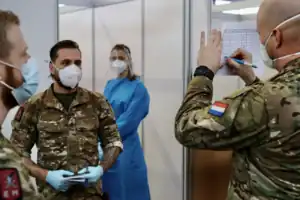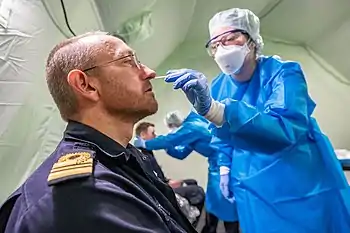COVID-19 pandemic in the Netherlands
The COVID-19 pandemic in the Netherlands has resulted in 8,618,815[1] confirmed cases of COVID-19 and 22,986[1] deaths.
| COVID-19 pandemic in the Netherlands | |
|---|---|
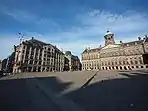 
| |
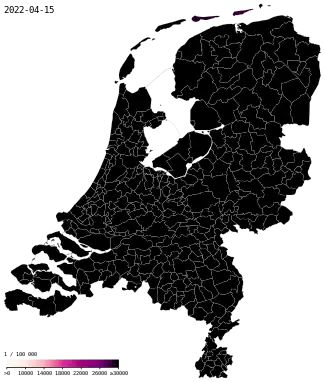
.svg.png.webp)
| |
| Disease | COVID-19 |
| Virus strain | SARS-CoV-2 |
| Location | Netherlands |
| Index case | Tilburg |
| Arrival date | 27 February 2020 (3 years, 7 months and 4 weeks) |
| Confirmed cases | 8,618,815[1][2] |
| Recovered | 8,585,131[3] |
Deaths | 22,986[1][2] |
| Fatality rate | 0.3% |
| Vaccinations | |
| Government website | |
| www | |
The virus reached the Netherlands on 27 February 2020, when its first COVID-19 case was confirmed in Tilburg.[5] It involved a 56-year-old Dutchman who had arrived in the Netherlands from Italy. The virus was confirmed to have reached Europe on 24 January 2020, when the first COVID-19 case was identified in Bordeaux - France. As of 31 January 2021, there are 978,475 confirmed cases of infections and 13,998 confirmed deaths. The first death occurred on 6 March, when an 86-year-old patient died in Rotterdam.[7]
On the advice of the Outbreak Management Team (OMT), under supervision of Jaap van Dissel, measures were taken by the Third Rutte cabinet for the public health to prevent the spread of this viral disease, including the "intelligent lockdown".[8] The government strategy on pandemic control has been criticised[9][10] for the refusal to acknowledge the role of asymptomatic spread and the role of masks in preventing spread,[11] as well as for the lack of testing capacity, in particular during the first half of 2020.[12] In March 2020, Prime Minister Mark Rutte called for herd immunity as an important method to stop the pandemic.[13] On 23 January 2021, as the government imposed a nationwide 9:00 p.m. curfew in a context of emergence of the British variant, the worst riots in 40 years broke out across the country.
Since the end of November 2021, the SARS-CoV-2 Omicron variant is spreading in parts of Europe (i.e. UK, Denmark and France). The number of registered new infections has risen strongly. There is a lockdown in the Netherlands from 19 December 2021 to (at least) 14 January 2022.[14]
As of 10 September 2022, a total of 36,105,753 vaccine doses have been administered.[15]
Background
On 12 January, the World Health Organization (WHO) confirmed that a novel coronavirus was the cause of a respiratory illness in a cluster of people in Wuhan, Hubei, China, who had initially come to the attention of the WHO on 31 December 2019.[16][17]
Unlike SARS of 2003, the case fatality rate for COVID-19[18][19] has been much lower, but the transmission has been significantly greater, with a significant total death toll.[20][18]
Timeline
January 2020
- As of 22 January 2020, the country's main international airport Schiphol was not taking extra measures against the spread of the virus, stating the lack of direct flights from or to Wuhan.[21]
- On 29 January the RIVM stated that the virus did not appear highly contagious, thus spread of COVID-19 in the Netherlands was unlikely.[22]
February 2020
- 22 February – 1 March: spring holiday for Dutch south and middle regions, where a significant number of families went skiing to Trentino, a northern province of Italy.[23]
- 26 February: the Dutch foreign ministry updated its travel advice for Italy, advising citizens not to travel to areas affected by the COVID-19 outbreak.[24]
- 27 February: the first confirmed case of COVID-19, a man from Loon op Zand who had been in the Lombardy region of Italy was admitted to Elisabeth-TweeSteden Hospital in Tilburg.[25][26]
- 28 February: a second case confirmed, a woman from Amsterdam who had visited the Lombardy region in Italy was in home isolation in Diemen.[27] She is an employee of the Academic Medical Center in Amsterdam.[28]
- 29 February: third and fourth cases confirmed, the husband and the youngest child of the second case.[29] On the same day the wife and daughter of the first case were also confirmed to have the virus.[30] Another case is a woman from Delft, who had recently been travelling to Italy and is isolated at home.[31][32]
1–10 March
- 1 March: three new cases were confirmed: a 49-year-old woman from Nieuwendijk who had been hospitalised at Erasmus MC in Rotterdam, a woman in Tilburg and a man in Dalen, Coevorden. The 49-year-old woman had been admitted to the Beatrix Hospital in Gorinchem on 21 February before being transferred to Rotterdam later. She arrived at the Beatrix Hospital with respiratory problems and stayed in intensive care for a week. A test for SARS-CoV-2 was not conducted since she had no connection to infected areas or people. Therefore, her infection went unnoticed for over a week. On 1 March it was announced that she had COVID-19 and that she had been relocated to Erasmus MC due to her deteriorating condition earlier. Since then the Beatrix Hospital went into lock-down out of precaution for a few days. Only personnel was allowed to enter and leave the building. The hospital fully reopened on 5 March, after all employees had tested negative.[33][34][35]
- 4 March: all of Northern Italy had an "only necessary travel"-advice. Some tourists were still in Italy, including a group of 900 students, something which received a lot of media attention.[36] In the Netherlands the total number of cases climbed to 38, which included one person passing through the Netherlands who was isolated in Hoofddorp.[37][38] The next day this number more than doubled to 82. According to Bruno Bruins, Minister for Medical Care, this was due to a catch-up in conducted tests.[39]
- 6 March: the National Institute for Public Health and the Environment (RIVM) announced the first death due to COVID-19, an 86-year-old patient.[7][40] The RIVM stated that most COVID-19 patients were infected in northern Italy and advised inhabitants of the North Brabant province to reduce their social contacts if they showed symptoms.[41]
- 9 March: the total number of cases was 321, of which more than one-third were found in North Brabant.[42][43] Prime Minister Mark Rutte asked citizens to stop shaking hands and asked people in North Brabant to remote work if possible.[44]
- 10 March: stricter measures were introduced in the province of North Brabant. Larger events were banned, including professional football, a number of dance festivals, carnival parades and concerts. A scholarship program was cancelled at the University of Eindhoven. In addition to this, Tilburg Mayor Theo Weterings called to limit social contacts for a week.[45]
11–20 March
- 12 March: the government announced new measures that will be in effect through the end of the month. All events (concerts, sports) and all meetings with more than 100 people are now forbidden and the RIVM is encouraging people to remote work. The restriction also applies to museums. All Dutch universities will suspend physical teaching until 1 April, but online teaching will continue. Schools remain open.[46]
- This press conference was the first time the government used a sign language interpreter to ensure good communication to deaf people. Irma Sluis filled this position and quickly gained some fame with her performance.[47][48]
- 13 March, the government cancelled all flights from China, Iran, Italy, and South Korea, the countries with the highest number of coronavirus cases, for two weeks. Flights leaving the destinations before 18:00 on that day could still land in the Netherlands.[49]
- 15 March: the total number of cases was 1,135. The Municipal Health Service (Gemeentelijke gezondheidsdienst, GGD) estimated that as of this day, 6,000 people in the Netherlands had been infected, as since 12 March people with mild complaints had not been tested any more.[50] Public measures were also tightened up. Schools and childcare centres will remain closed until 6 April, as well as cafés, restaurants, sports clubs, saunas, sex clubs and coffeeshops.[51]
- 16 March: in the evening Prime Minister Mark Rutte addressed the nation about the coronavirus. It was the first time a Prime Minister had addressed the nation since the 1973 oil crisis.[52] In his speech he announced that the government chooses not to resort to population confinement measures, but to rely on the measures taken earlier to try to assert maximum control over the spread of the virus. Reasoning that the virus is here to stay, the preferred approach would be to tackle the epidemic by building population immunity.[53]
- 17 March: the total number of confirmed cases was 1,705, of which 314 patients had been admitted to the hospital.[54][2] Arie Slob notified that schools could stay open for the sole purpose of letting final exam candidates finish their last schoolwork. Schools will only open if certain conditions are met. This measure is taken to ensure that final exam candidates are prepared for the national exam at the start of May.
- 18 March: the Minister for Medical Care, Bruno Bruins, became unwell during a parliamentary debate and collapsed.[55] On 19 March he resigned from his position. In a press conference it was announced that Health Minister Hugo de Jonge would from then on handle the coronavirus pandemic in the Netherlands.[56]
- 19 March: a traveller from the Netherlands was described as "Patient Zero of the Winelands" in South Africa.[57]
- 20 March: in a press conference it was announced that Martin van Rijn would become the new Minister for Medical Care.[58] In the evening, King Willem-Alexander addressed the nation due to the coronavirus outbreak.[59]
21–31 March
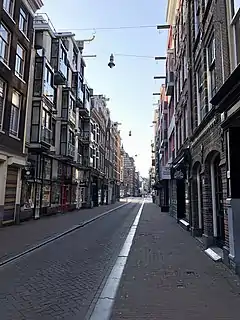
- 22 March: the NOC*NSF (Dutch Olympic Committee*Dutch Sports Federation) sent a letter to the IOC stating the advice that the 2020 Summer Olympics only can take place when the coronavirus crisis is under control worldwide.[60] The NOC also asked for more certainty for the athletes. The letter was supported by most of the National Sport Federations.[61]
- 23 March: stricter social distancing rules were announced in a press conference.[62]
- 24 March: in a press conference, the Minister for Primary and Secondary Education announced all final examinations (centraal eindexamen) for secondary education would be cancelled.[63]
- 26 March: the NOC*NSF (Dutch Olympic Committee*Dutch Sports Federation) provided hundreds of cooling vests for healthcare personnel at the intensive care departments in several hospitals. Doctors have to work in warm conditions among others due to the protective clothing they have to wear. The vests would initially be used by the Dutch athletes at the 2020 Summer Olympics.[64]
- 29 March: the total number of positive coronavirus cases in the country surpassed 10,000. Upon the announcement, RIVM stated that 'the number of hospitalised patients and the number of deaths are increasing less quickly than would have been expected without measures'. It further said that since testing was done mostly only for the very sick and healthcare workers, the actual number of infections is likely to be far higher.[65]
- 31 March: in a press conference it was announced that all measures initiated on 15 March will be extended until 28 April.[66]
April 2020

- 7 April: Prime Minister Mark Rutte announced in a press conference that the measures could possibly be loosened a bit after 28 April, however getting back to 'normal' will take considerable time. Furthermore, the Dutch Government are researching possibilities to use an app to register corona infections and use this app to warn others who were in proximity of an infected person. However, concerns were raised whether this app would harm privacy.[67]
- 8 April: this day marked the first day since the outbreak in the Netherlands that the number of corona patients in intensive care units declined. It was a sign to many that the curve was 'flattened' in the Netherlands.[68]
- 15 April: Prime Minister Mark Rutte held a press conference. The numbers of infections, deaths and hospitalisations were declining. He announced that loosening the measures could only be done in small steps, and with several restrictions in mind: keeping 1.5 meter distance, sufficient health care capacity and adequate protection of older and/or weaker people.[69]
- 20 April: a total number of 32,655 people tested positive for COVID-19 and 3,684 people died due to the coronavirus. Admittance to hospitals and ICUs was steadily declining, leading to conclusions that the lock-down measures had the desired effect.[70]
- 21 April: All measures were extended until 20 May. An exception was made for elementary schools: these will open on 11 May. Mark Rutte also announced that secondary education would gradually open after 2 June.[71] Furthermore, events that require a permit are forbidden until 1 September. Among others this means that football matches are also not allowed, resulting in the end of the 2019–20 Eredivisie season.[72]
- 23 April: research of the RIVM indicated that the first infection in the Netherlands was possibly on 15 February, almost two weeks before the first confirmed infection. Among others this research was based on patients who had similar symptoms but were not tested for COVID-19.[73]
- 26 April: COVID-19 was confirmed in mink at two fur farms in the Netherlands, the agriculture ministry confirmed.[74]
- 28 April: after the Netherlands Trade and Investment Office was renamed "Netherlands Office Taipei" to reflect the increased scope of cooperation between the two countries, the Chinese ambassador expressed discontent, demanded a clarification of the name change, and reminded the Dutch government to dutifully adhere to the one-China principle. The Global Times warned of a backlash and claimed that users of Chinese social media sites had called for China to immediately stop exporting medical supplies to the Netherlands and that Chinese citizens were demanding a boycott of Dutch products and cancelling their travel plans to the Netherlands.[75]
May 2020
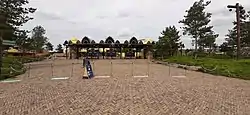
- 6 May: the government announces that starting from 11 May so-called "contact jobs" such as hairdressers and beauty salons, can open again. From 1 June, bars can open their outside areas again.[76] From that date the government also aims to test anyone with COVID-19 symptoms, instead of only health care workers. The advice "Stay home" changes to "Stay home when showing symptoms". Face masks become mandatory in public transport, despite the RIVM still doubting the effectivity.[77]
- 7 May: Minister Hugo de Jonge indicates in a letter to the House of Representatives that large-scale events will not be possible until a vaccine is found.[78]
- 11 May: indoor pools were also allowed to open again. Visitors were required to dress at home beforehand and shower at home afterward. All visitors older than 12 years old had to maintain a 1.5 meter distance.[79]
- 19 May: in a press conference the government announced that more restrictions could be loosened, provided that no new outbreaks will occur. From 2 June secondary schools partly opened for students. From 8 June primary schools fully opened. And from 15 June onwards, middle level (mbo) and high educations (hbo/wo) partly opened.[80]
June 2020
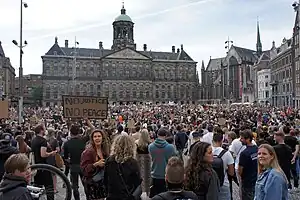
- 1 June: bars and restaurants are allowed to open from 12:00. Inside a maximum of 30 guests are allowed who have to reserve beforehand. On outdoor terraces no maximum is enforced. Both in- and outside guests and personnel have to maintain 1.5 meter distance, unless they are from the same household.[81] On this day there was also a large demonstration on Dam Square in Amsterdam. This was part of the George Floyd protests. About 5,000 people converged on the square. While most of them wore face masks, it was impossible to maintain 1.5-metre distance.[82] The mayor of Amsterdam, Femke Halsema, opted to not stop the demonstration, as she feared riots. She faced harsh criticism afterwards, as this demonstration could cause a new outbreak of COVID-19.[83] However, almost no cases linked to the demonstration (or similar demonstrations in other cities) were found in the weeks after.[84]
July 2020–present: second wave
_-_proof_of_vaccination_against_COVID-19.png.webp)
Since mid-July, there has been a large increase in positive cases, from about 50 positive tested people/day to over 7,000 positive tested people per day. Measures were tightened in late September to achieve control over the spread again. About 1 in 120 people were deemed infectious in late September. A record number of 11,107 new cases in one day was reported on 30 October.[85]
From 14 October 22:00, a partial lockdown came into effect.[86] Cafes, restaurants, and bars were to be closed for at least two weeks. Starting 1 December, masks were made compulsory to wear while indoors.[87]
From 15 December 2020 through at least 15 March 2021, a hard lockdown is in effect, and all non-essential shops are closed.
On 19 December 2020, it was discovered that a mutant strain of COVID-19, Variant of Concern 202012/01, had entered the Netherlands. The Dutch government banned flights from the United Kingdom, where the strain was originally identified, in response. The travel ban is scheduled to remain in place until at least 1 January.[88][89][90]
Shortly after Christmas 2020, most European countries started COVID-19 vaccination programs, however the Netherlands expected to start vaccination on 8 January 2021.[9] The government cited issues with the digital registration system as the cause of the delayed vaccination start.[91]
As of 9 January 2021, a total of 30,000 healthcare workers had been vaccinated,[92] and 96 cases of the Lineage B.1.1.7 variant have been reported. As of 16 January 2021, 200 cases of that variant have been reported.[93] These cases cause extra concern, as this variant is suspected to be more contagious, with a reproduction number estimated to 1.3.[94]
As of 26 January 2021, over 173,000 people had gotten vaccinated.[95]
In January 2021, it was discovered that personal data of people in the contact tracing database was illegally sold to fraudsters by call center employees having access to them.[96] A few days earlier, employees of testing company U-diagnostics were found to have shared personal data in a WhatsApp group of 300 employees, violating the GDPR privacy regulations.[97]
January 2021 curfew and protests
Starting on 23 January 2021, the Dutch government introduced a curfew as means to curb the epidemic. On 24 January 2021, violent protests erupted as a reaction.[98][99] The curfew, imposed between 9 pm to 4:30 am, was the first of its kind to be enacted in the country since the Second World War.[98][100] Protests took place in most major cities, including Amsterdam and Eindhoven. Police made hundreds of arrests and issued thousands of fines.[98][101][99] The Dutch Police Association described the riots at the worst violence in Netherlands in the last 40 years.[98] The protests have been described as being composed of mostly young men.[98][101]
An opinion poll by public broadcaster NOS indicated that the curfew was supported by seven out of 10 Dutch respondents, with just 18% of the population opposing it.[101] A lawsuit started by Willem Engel's Viruswaanzin (later renamed Viruswaarheid) challenged the legal justification for the curfew, and while a lower court found that the government's justification was lacking, the matter was quickly remedied.[102]
Exceptions to the curfew have been made for several groups of people, including medical emergencies, essential jobs, including delivery, and walking dogs on a leash.[103]
June 2021
On June 5, an openingsplan[104] cancelled many COVID restrictions. Three weeks later, the number of new infections rose massively.
July 2021
On July 10, 2021, the government reintroduced a series of restrictive measures due to a rapid increase in infections. All restaurants and bars must be closed from midnight until 06.00.[105][106] The measures will remain in place until 14 August 2021.[107]
November 2021 protests and riots
In November 2021, the government proposed implementing the "2G rule", a measure to only allow individuals who are vaccinated (gevaccineerd) or have recovered from a COVID-19 infection (genezen) from being able to enter hotels, restaurants, cafes, cultural and artistic places, and events, and to use non-essential services.[108] On November 19, a protest against the 2G rule was announced on social media, which turned into a riot. The police shot several people.[109][110]
Most notably, riots occurred in Rotterdam, where 51 people were arrested. There were also riots in Stein, Roermond, Urk, The Hague, Enschede, Leeuwarden and Tilburg. The authorities used water cannons, police dogs and mounted police against the rioters. Three rioters were seriously injured when police opened fire on them, while a fourth sustained minor injuries. Additionally, four rioters and five police officers sustained minor injuries during the unrest. Peaceful protests also took place in Amsterdam and Breda.[111][112][113][114][115][116][117]
December 2021
On 19 December, a lockdown began. It lasted until 14 January 2022.[14] Only essential facilities, such as food stores and pharmacies, stayed open, and only during reduced hours. Schools and educational facilities were closed; in particular, the school Christmas holidays started one week earlier. Public transport continued to operate, although schedules were adjusted.
January 2022
On January 3, 2022, following winter break, the government opened primary and secondary schools again. Tertiary schools — middle and higher education — remained closed.[118]
Spring 2022
The face mask requirement on public transport was removed on 23 March 2022. The move was further relaxed in airports and on planes on 21 May 2022.[119]
Prevention measures and response
In late March, the government announced strict social distancing rules as cases surged over 5,000. All large public events and gatherings are banned until 1 September. Furthermore, in public space a distance of at least 1.5 metres between people not from the same household must be observed, and shops and other venues are to enforce this distancing among their visitors. Fines will be issued to those not complying with the new rules. Companies may face a fine up to €4,000, individuals risk a fine up to €400. Prime Minister Mark Rutte repeated his call to keep distance from each other.[62] Final examinations of secondary school were cancelled on 24 March.[63] Other measures were that schools and day-cares were closed, except for children whose parents work in the 'vital' sectors, like health care. People were required to remote work as much as possible. These measures also resulted in modified schedules for public transport, as much less transportation of individuals was necessary.[120]
Reaction to second wave
As a response to the large increase in positive tests since July, the Dutch government released additional regulations on 13 October. These include:[121]
- Closing the hospitality industry.
- Banning the sale of alcohol in the evening, as well as closing non-essential stores.
- Limiting group sizes and the number of guests received at home.
- Banning events and amateur sports for adults.
- Requiring face masks in public indoor spaces, including schools outside classrooms.
Additionally the government advised people to remote work and limit unnecessary travel.[86]
Holiday season
The Dutch government also stated that people should be mindful of the regulations during the holiday season. Sint Maarten, a holiday where children collect sweets from neighbours, was still held with social distancing and maximum group size regulations in place. Sinterklaas was also held with the same regulations, with people also being advised not to delay holiday shopping to the last possible moment.[122]
In November 2020, the government also announced that it would ban fireworks on New Year's Eve (traditionally the only time of the year that consumers are allowed to purchase and ignite fireworks), citing that firework-related injuries would put too much stress on the healthcare system during the pandemic.[123][124][125]
Reaction to the B.1.1.7 variant
In January 2021, the government extended its regulations and considered tightening them to limit the spread of Lineage B.1.1.7, which is estimated to be more contagious.[126]
Contact tracing application
The Dutch Ministry of Public Health officially maintains an application called CoronaMelder for Android and iOS.[127] The applications, including the backend are open source software under the European Union Public License.[127][128]
CoronaMelder launched nationwide on 10 October 2020, and was downloaded 2.6 million times two days later. The maintainers stated that they are unable to track the number of users that actively use the application owing to privacy reasons.[129] Later that month on 26 October the app had reportedly 3.5 million downloads and around 14,000 reports of positive test results.[130]
Testing
By mid-March, the country could test about 1,000 samples per day, which is less than the capabilities of other European countries.[131] This also explains a relatively large ratio of the number of deaths to the number of confirmed cases.[132] As of 25 March, 2,500 samples have been tested daily and a total number of 38,000 tests performed. Because of the limited availability of testing capacity, certain groups were prioritised in testing, such as healthcare workers, elderly, and people with acute symptoms.[133] A lack of testing capacity causes a distinct number of deaths by COVID-19 that are not registered as such, although local doctors can recognise the symptoms.[134] By the end of March, the country was testing about 4,000 people per day, with the goal of expanding the testing capacity to about 17,500 daily tests in a couple of weeks. Once such a testing capacity has been reached the Dutch government wants to expand its testing capacity to 29,000 tests a day.[135] According to a report by the RIVM, an average of 4,280 tests per day have been performed in the period between 9 March and 26 April.[136] Several health organisations have started testing themselves, claiming the procedures of the GGD testing centers take too long.[137]
In a press conference on 6 May, the government announced that starting from 1 June it wants to test all people with COVID-19 symptoms. The coordination has been criticised, with the regional GGD offices stating there is no clear national plan to scale up testing.[138] Nonetheless, the test capacity was increased to 30,000 per day with the GGDs being able to conduct 600 to 2400 contact traces for positively tested applicants with 2-8% of the tests done assumed to result positive for the virus.[139] On 1 June, a national telephone number was made public through which a test time and location could be scheduled. The new system, although initially overwhelmed by the number of callers on the first day, tested 50,000 people in the first week and had 100,000 applicants by 11 June.[140][141] By 9 June, most regions where successful in handling the increased demand, with people often being able to schedule a test the same day or the day after.[142] The GGDs strive for a test result to be made known to the applicant within 48 hours, with 96% of results being successfully returned within that time by 11 June.[141]
Impact
In response to regulations announced on 12 March, panic buying of food, toilet paper and medicines, resulted in empty shelves in supermarkets. Prime Minister Mark Rutte appealed to the nation to stop this behaviour.[143] On 12 March it was announced that all public events with more than 100 people will be cancelled until 6 April.[144] On 24 March this period was extended to 1 June for all permit-requiring events.[145] Three days later it was announced in a press conference that all restaurants, museums, sport clubs and schools had to close.[51] A Dutch "grassroots" initiative, Mond Kapjes Nodig[146] was formed to address the local PPE shortages. More than 400,000 masks[147] were delivered within weeks to those fighting the pandemic in the Netherlands. This helped relieve the coordination efforts on a national level.
Economic
On 26 March, the Bureau for Economic Policy Analysis published the first calculations of the economic expectations. These expectations are based on the length of the prevention measures against the coronavirus pandemic. If these measures are present for three months, the Dutch economy is expected to shrink by 1.2 per cent in 2020. If these measures are required for a year the economy would decline by 10 per cent.[148] In all cases it is expected that the economy will slightly grow the following year.
On 8 June, three months into the crisis, an analysis of Rabobank was published. They expected that the economy between March and June shrunk by 8%, with the catering sector being hit the most. They expected that, whereas the crisis was over the peak, the economy would continue shrinking, and the industries, in particular the construction industry, which were doing relatively well, would be hit as well. The forecast was that the unemployment rate would grow from 3% to 7% by the end of 2020.[149]
As a result of the ban on fireworks for the 2020-2021 New Year's Eve the Dutch government has compensated the fireworks industry for around 40 million euros.[125]
Statistics
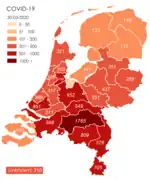 Municipal Health Service (GGD) regions by number of COVID-19 infections during the first wave (30 March 2020)[2]
Municipal Health Service (GGD) regions by number of COVID-19 infections during the first wave (30 March 2020)[2]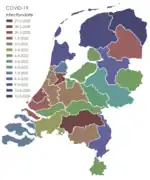 Municipal Health Service (GGD) regions by date of first COVID-19 infection[2]
Municipal Health Service (GGD) regions by date of first COVID-19 infection[2]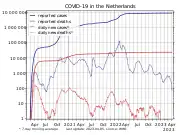 Number of cases (blue), number of deaths (red), and their respective increments (dotted lines) on a logarithmic scale
Number of cases (blue), number of deaths (red), and their respective increments (dotted lines) on a logarithmic scale
Total confirmed cases, hospitalisations and deaths
New confirmed cases per day
New deaths per day
New hospitalisations per day
New IC admissions per day
Growth rate of confirmed cases
(a rising straight line indicates exponential growth, while a horizontal line indicates linear growth)
Confirmed COVID-19 cases by GGD district
|
Confirmed COVID-19 cases by sex and age
|
| ||||||||||||||||||||||||||||||||||||||||||||||||||||||||||||||||||||||||||||||||||||||||||||||||||||||||||||||||||||||||||||||||||||||||||||||||||||||||||||||||||||||||||||||||||||||||||||||||||||||||||||||||||||||||||||||||||||||||||||||||||||||||||||||||||||||||||||||||||||||||||||||||||
Notable deaths
| Name | Known for | Date (Aged) |
|---|---|---|
| Harry Aarts | Politician | 25 March 2020 (aged 90) |
| Kees Bakker | Football chairman and police officer | 25 March 2020 (aged 76) |
| Kim H. Veltman | Historian | 1 April 2020 (aged 71) |
| Hans Prade | Surinamese diplomat and politician | 3 April 2020 (aged 81) |
| Frits Flinkevleugel | Footballer | 10 April 2020 (aged 80) |
| Ing Yoe Tan | Lawmaker | 10 April 2020 (aged 71) |
| Bas Mulder | Dutch-Surinamese priest | 10 April 2020 (aged 88) |
| Kishen Bholasing | Surinamese singer | 12 April 2020 (aged 35) |
| Martine Crefcoeur | Actress | 18 April 2020 (aged 84) |
| Ton van den Heuvel | Make-up artist | 19 April 2020 (aged 94) |
| Koos van den Berg | Politician | 21 April 2020 (aged 77) |
| Henk Overgoor | Footballer | 23 April 2020 (aged 75) |
| Chavalit Soemprungsuk | Thai painter | 27 April 2020 (aged 80) |
| Hans Cohen | Microbiologist | 14 May 2020 (aged 97) |
| Bram van der Vlugt | Actor | 19 December 2020 (aged 86) |
See also
Notes
External links
References
- Ritchie, Hannah; Mathieu, Edouard; Rodés-Guirao, Lucas; Appel, Cameron; Giattino, Charlie; Ortiz-Ospina, Esteban; Hasell, Joe; Macdonald, Bobbie; Beltekian, Diana; Dattani, Saloni; Roser, Max (2020–2022). "Coronavirus Pandemic (COVID-19)". Our World in Data. Retrieved 25 October 2023.
- "Current information about COVID-19 (novel coronavirus)". rivm.nl. 10 January 2021. Retrieved 10 January 2021.
- "COVID - Coronavirus Statistics - Worldometer". Retrieved 25 April 2023.
- "COVID-19-vaccinaties". rijksoverheid.nl (in Dutch). Retrieved 8 October 2021.
- "Man diagnosed with coronavirus (COVID-19) in the Netherlands - News item - Government.nl". Government of the Netherlands. 27 February 2020. Retrieved 10 January 2021.
- "Patiënt met nieuw coronavirus overleden". rivm.nl (in Dutch). 6 March 2020. Retrieved 7 March 2020.
- Maarten Keulemans (12 March 2020). "Are we doing enough? RIVM boss Van Dissel: 'As soon as something indicates infection in the family: isolation'". de Volkskrant (in Dutch). Retrieved 13 March 2020.
- Pietsch, Bryan (27 December 2020). "E.U. Starts Effort to Vaccinate 450 Million". The New York Times. ISSN 0362-4331. Retrieved 28 December 2020.
- O'Leary, Naomi (10 March 2020). "How Dutch false sense of security helped coronavirus spread". The Irish Times. Retrieved 10 December 2020.
- Sterling, Toby (5 August 2020). "With no nationwide rule, Amsterdam insists on virus masks". Reuters. Retrieved 10 December 2020.
- "Ministers under fire over coronavirus failures, eight more regions set to get new measures". DutchNews.nl. 23 September 2020. Retrieved 10 December 2020.
- "'50 tot 60 procent Nederlanders moet corona krijgen voor groepsimmuniteit'". nos.nl (in Dutch). 17 March 2020. Retrieved 10 December 2020.
- http://www.rijksoverheid.nl: Verspreiding omikron vertragen: Nederland in lockdown
- "Netherlands: WHO Coronavirus Disease (COVID-19) Dashboard With Vaccination Data". covid19.who.int. Retrieved 27 February 2023.
- Elsevier. "Novel Coronavirus Information Center". Elsevier Connect. Archived from the original on 30 January 2020. Retrieved 15 March 2020.
- Reynolds, Matt (4 March 2020). "What is coronavirus and how close is it to becoming a pandemic?". Wired UK. ISSN 1357-0978. Archived from the original on 5 March 2020. Retrieved 5 March 2020.
- "Crunching the numbers for coronavirus". Imperial News. 13 March 2020. Archived from the original on 19 March 2020. Retrieved 15 March 2020.
- "High consequence infectious diseases (HCID); Guidance and information about high consequence infectious diseases and their management in England". GOV.UK. Archived from the original on 3 March 2020. Retrieved 17 March 2020.
- "World Federation Of Societies of Anaesthesiologists – Coronavirus". wfsahq.org. Archived from the original on 12 March 2020. Retrieved 15 March 2020.
- "Schiphol en airlines treffen nog geen maatregelen tegen coronavirus". Nu.nl (in Dutch). 22 January 2020. Archived from the original on 23 January 2020. Retrieved 22 January 2020.
- "Het coronavirus, dit zijn de feiten". RTL Nieuws (in Dutch). 29 January 2020. Retrieved 8 January 2021.
- "Overzicht schoolvakanties 2019-2020". Archived from the original on 14 September 2020. Retrieved 7 May 2020.
- "Dutch update Italy travel advice as coronavirus takes hold". DutchNews.nl. 25 February 2020. Retrieved 27 February 2020.
- "Patient with novel coronavirus COVID-19 in the Netherlands". rivm.nl. 27 February 2020. Retrieved 6 March 2020.
- "RIVM: Eerste coronageval in Nederland". De Telegraaf (in Dutch). 27 February 2020. Retrieved 6 March 2020.
- "Tweede patient in Nederland met COVID-19". rivm.nl (in Dutch). 28 February 2020. Retrieved 6 March 2020.
- "Amsterdamse coronapatiënt werkt in Amsterdam UMC". nos.nl (in Dutch). 28 February 2020. Retrieved 28 February 2020.
- "Twee contacten testen positief voor COVID-19". rivm.nl (in Dutch). 29 February 2020. Retrieved 6 March 2020.
- "Ook enkele contacten van Tilburgse patiënt testten positief voor COVID-19". rivm.nl (in Dutch). 29 February 2020. Retrieved 6 March 2020.
- "Patiënt met COVID-19 in Delft". rivm.nl (in Dutch). 29 February 2020. Retrieved 6 March 2020.
- "Ook vrouw in Delft heeft corona, zevende geval in Nederland". NOS (in Dutch). 29 February 2020. Retrieved 1 March 2020.
- "Drie nieuwe patiënten met COVID-19". rivm.nl (in Dutch). 1 March 2020. Retrieved 6 March 2020.
- "Beatrixziekenhuis Gorinchem gesloten om coronavirus, tien patiënten in NL". nos.nl (in Dutch). 1 March 2020. Retrieved 6 March 2020.
- "Beatrixziekenhuis Gorinchem en Lingepolikliniek Leerdam donderdag weer open na melding coronavirus". DeStadGorinchem.nl (in Dutch). 4 March 2020. Retrieved 6 March 2020.
- "Verwarring over reisadvies, maar toeristen in Noord-Italië skiën door". NRC Handelsblad (in Dutch). 4 March 2020. Retrieved 14 April 2020.
- "Coronapatiënt die in container Hoofddorp zat nu naar andere locatie". nos.nl (in Dutch). 4 March 2020. Retrieved 4 March 2020.
- "Ook ziekenhuispersoneel in Eindhoven, Breda en Den Bosch besmet met corona". nos.nl (in Dutch). 5 March 2020. Retrieved 7 March 2020.
- "Aantal coronapatiënten in Nederland ruim verdubbeld naar 82". Algemeen Dagblad (in Dutch). 5 March 2020. Retrieved 6 March 2020.
- "First coronavirus fatality in Netherlands: Rotterdam patient dead at 86". nltimes.nl. 6 March 2020. Retrieved 6 March 2020.
- "COVID-19: Nieuwe aanwijzing voor inwoners Noord-Brabant". RIVM (in Dutch). 6 March 2020. Retrieved 9 May 2020.
- "Aantal met coronavirus besmette personen in Nederland stijgt naar 321". nu.nl (in Dutch). 9 March 2020. Retrieved 9 March 2020.
- "Geen nieuwe besmettingen met coronavirus in Gooi, Vechtstreek en Eemland; aantal zieken blijft op 22". noordhollandsdagblad.nl (in Dutch). 9 March 2020. Retrieved 9 March 2020.
- "Rutte: stop met handen schudden en werk thuis". Nederlandse Omroep Stichting (in Dutch). 9 March 2020.
- "Brabant scherpt maatregelen rondom coronavirus aan". NRC (in Dutch). 10 March 2020. Retrieved 10 March 2020.
- "Events with 100+ visitors forbidden, cabinet calls for working from home". 13 March 2020.
- Bibi Berenschot (12 March 2020). "De overheid luistert: voor het eerst een gebarentolk bij persconferentie". Trouw. Retrieved 31 March 2020.
- Alex Mazereeuw & Wilfred Takken (24 March 2020). "Hamsterende gebarentolk Irma Sluis groeide uit tot een baken in de crisis". NRC Handelsblad. Retrieved 31 March 2020.
- "Kabinet schrapt vluchten uit China, Italië, Iran en Zuid-Korea". nu.nl (in Dutch). 13 March 2020.
- "Acht nieuwe coronadoden, 162 mensen opgenomen in ziekenhuis". nos.nl (in Dutch). 15 March 2020. Retrieved 15 March 2020.
- "Alle scholen, cafés en restaurants tot en met 6 april dicht om coronavirus". NOS (in Dutch). 15 March 2020. Retrieved 16 March 2020.
- Bekkum, Dylan van (16 March 2020). "Live toespraak van Rutte is een absolute zeldzaamheid". de Volkskrant (in Dutch). Retrieved 16 March 2020.
- "Television address by Prime Minister Mark Rutte of the Netherlands". government.nl. 16 March 2020. Retrieved 31 March 2020.
- "19 nieuwe sterfgevallen in Nederland, bevestigde besmettingen naar 1.705". nu.nl (in Dutch). 17 March 2020. Retrieved 17 March 2020.
- "'Oververmoeide' minister Bruins zakt in elkaar tijdens coronadebat". nos.nl (in Dutch). 18 March 2020. Retrieved 20 March 2020.
- Hommes, Kick (19 March 2020). "Oververmoeide minister Bruno Bruins treedt af". Trouw (in Dutch). Retrieved 20 March 2020.
- Knowler, Wendy (17 March 2020). "'Patient Zero of the winelands': Cape estates close over coronavirus". DispatchLive.co.za. Retrieved 19 March 2020.
- "PvdA'er Martin van Rijn nieuwe minister voor Medische Zorg". nos.nl (in Dutch). 20 March 2020. Retrieved 20 March 2020.
- "Koning: coronavirus kunnen we niet stoppen, eenzaamheidsvirus wel". nos.nl (in Dutch). 20 March 2020. Retrieved 20 March 2020.
- https://nocnsf.nl/media/2511/brief-nocnsf-aan-ioc_os-tokyo-2020.pdf
- "Meeste sportbonden steunen brief NOC*NSF aan IOC". Algemeen Dagblad (in Dutch). 23 March 2020.
- "Centrale eindexamens middelbare scholieren gaan niet door". nos.nl (in Dutch). 24 March 2020. Retrieved 24 March 2020.
- "Koelvesten voor IC-medewerkers beschikbaar gesteld: 'Het is net topsport'". nos.nl (in Dutch). 26 March 2020. Retrieved 27 March 2020.
- "Dutch coronavirus cases pass 10,000 -health authorities". National Post. 29 March 2020. Retrieved 30 March 2020.
- "Kabinet verlengt maatregelen tegen corona tot en met 28 april". nos.nl (in Dutch). 31 March 2020. Retrieved 31 March 2020.
- "Dit was het belangrijkste coronanieuws van dinsdag 7 april". Het Parool (in Dutch). 7 April 2020. Retrieved 7 April 2020.
- "Het coronanieuws van woensdag 8 april: bijlezen in één minuut". AD (in Dutch). 8 April 2020. Retrieved 8 April 2020.
- "Dit was het belangrijkste coronanieuws van dinsdag 15 april". Het Parool (in Dutch). 15 April 2020. Retrieved 20 April 2020.
- "Epidemiologische situatie COVID-19 in Nederland 19 april 2020". RIVM (in Dutch). 20 April 2020. Retrieved 20 April 2020.
- "Lockdown tot 20 mei verlengd, kinderen vanaf 11 mei helft van tijd naar school". NU (in Dutch). 21 April 2020. Retrieved 21 April 2020.
- "Definitief geen betaald voetbal tot 1 september". AD (in Dutch). 21 April 2020. Retrieved 22 April 2020.
- "Het coronavirus was al veel langer in Nederland". AD (in Dutch). 23 April 2020. Retrieved 23 April 2020.
- "Coronavirus identified on two mink farms in the Netherlands". dutchnews.nl. 26 April 2020. Retrieved 3 May 2020.
- News, Taiwan (30 April 2020). "China threatens to halt medical supplies after Netherlands changes Taiwan rep office name". Taiwan News. Retrieved 3 May 2020.
{{cite news}}:|last1=has generic name (help) - "Zo ziet de versoepeling van de coronamaatregelen er in de komende maanden uit". nos.nl. 6 May 2020. Retrieved 7 May 2020.
- "Van Dissel heeft begrip voor mondkapjesplicht, maar blijft kritisch". nos.nl. 7 May 2020. Retrieved 7 May 2020.
- "Geen grote evenementen zolang er geen vaccin is". nos.nl. 7 May 2020. Retrieved 7 May 2020.
- "Protocol Verantwoord Zwemmen" (PDF). watervrij.nl (in Dutch). 8 May 2020. Archived from the original (PDF) on 3 June 2020. Retrieved 3 June 2020.
- "Corona-aanpak: de volgende stap". Rijksoverheid.nl (in Dutch). 19 May 2020. Retrieved 3 June 2020.
- "Corona-aanpak: de volgende stap". Rijksoverheid.nl (in Dutch). 19 May 2020. Retrieved 6 June 2020.
- "Duizenden demonstranten tegen politiegeweld: Dam in Amsterdam bomvol". AD (in Dutch). 1 June 2020. Retrieved 7 June 2020.
- "Felle kritiek op Halsema vanuit politiek Den Haag: 'Ze had in moeten grijpen'". nos.nl (in Dutch). 2 June 2020.
- "'Twee weken na demonstraties nog geen coronabesmettingen gemeld'". RTL Nieuws (in Dutch). 16 June 2020. Retrieved 29 June 2020.
- Lochem, Sander van Mersbergen en Tamo van (8 December 2020). "Nederland krijgt tweede golf er niet onder: eigen schuld?". Het Parool (in Dutch). Retrieved 10 December 2020.
- Veiligheid, Ministerie van Justitie en; Ministerie van Volksgezondheid, Welzijn en Sport (13 October 2020). "Partial lockdown needed to bring down infections - News item - Rijksoverheid.nl". rijksoverheid.nl.
- Hague, Peter Cluskey in The. "Coronavirus: Mask-wearing becomes compulsory indoors in the Netherlands". The Irish Times. Retrieved 10 December 2020.
- "Netherlands ban flights from UK after detecting new coronavirus strain". Reuters. 20 December 2020. Retrieved 20 December 2020.
- Welle (www.dw.com), Deutsche. "Coronavirus digest: Dutch government bans UK flights over new virus strain | DW | 20 December 2020". Deutsche Welle. Retrieved 20 December 2020.
- Reporters, Telegraph (20 December 2020). "Netherlands bans UK flights as coronavirus 'mutation' spreads outside Britain". The Telegraph. ISSN 0307-1235. Archived from the original on 11 January 2022. Retrieved 20 December 2020.
- Klaassen, Niels (17 December 2020). "Harde kritiek uit Kamer over 'late' start inenting in Nederland". Het Parool (in Dutch). Retrieved 28 December 2020.
- "Na vier dagen 30.000 medewerkers acute zorg geïnjecteerd". NOS (in Dutch). 9 January 2021. Retrieved 10 January 2021.
- "Could the British variant be more widespread in The Netherlands than currently assumed?". NL Times. Retrieved 17 January 2021.
- "Grote zorgen bij OMT over Britse variant, 'nu maatregelen nemen'". nos.nl (in Dutch). 18 January 2021. Retrieved 18 January 2021.
- "Vaccinaties Dashboard coronavirus" (in Dutch). Rijksoverheid. 26 January 2021. Archived from the original on 26 January 2021. Retrieved 26 January 2021.
- "Illegale handel in privégegevens miljoenen Nederlanders uit coronasystemen GGD". RTL Nieuws (in Dutch). 25 January 2021. Retrieved 26 January 2021.
- "Persoonsgegevens tienduizenden geteste Nederlanders onvoldoende beveiligd". nos.nl (in Dutch). 21 January 2021. Retrieved 26 January 2021.
- Khan, Mehreen (26 January 2021). "Dutch extend Covid curfew despite violent backlash". Financial Times. Retrieved 27 January 2021.
- Henley, John (26 January 2021). "Netherlands shaken by third night of riots over Covid curfew". The Guardian. Retrieved 27 January 2021.
- Cunningham, Erin (25 January 2021). "Riots explode across Netherlands over covid restrictions, with Dutch leader calling participants criminals". The Washington Post. Retrieved 27 January 2021.
- Pop, Valentina (26 January 2021). "Dutch Rioters Clash With Police for Third Night Over Covid-19 Curfew". The Wall Street Journal. Retrieved 27 January 2021.
- "Kabinet was overrompeld door uitspraak over avondklok". Het Parool. 17 February 2021.
- "MP's approve 9 p.m. curfew in the Netherland starting Saturday". Nl Times. 21 January 2021.
- "www.rijksoverheid.nl". Archived from the original on 2 June 2021. Retrieved 11 August 2021.
- "No choice but to take summertime measures in face of rapid increase in infections". 9 July 2021. Retrieved 14 July 2021.
- "Netherlands re-imposes COVID-19 curbs due to infection surge". Reuters. 9 July 2021.
- "Rules for tourism businesses and events - Measures tightened from 10 July until 13 August". Retrieved 13 July 2021.
- "Wetsvoorstel: 2G voor horeca, evenementen en cultuur". NOS (in Dutch). 23 November 2021. Archived from the original on 22 November 2021. Retrieved 29 November 2021.
- "Zeven gewonden en zeker twintig arrestaties na coronarellen Rotterdam". RTL Nieuws (in Dutch). 20 November 2021. Archived from the original on 19 November 2021. Retrieved 29 November 2021.
- "'Gericht op benen geschoten', wat we nu weten over de rellen in Rotterdam". NOS. 20 November 2021. Archived from the original on 20 November 2021. Retrieved 29 November 2021.
- "48 Arrested In Netherlands' Second Night Of Riots Over Covid Curbs". NDTV.com. Retrieved 22 November 2021.
- "More arrests in Netherlands riots one night after "orgy of violence" over COVID-19 restrictions". www.cbsnews.com. 21 November 2021. Retrieved 22 November 2021.
- "COVID protests in Netherlands turn violent for a second night". www.aljazeera.com.
- "Fresh Covid demos in riot-hit Netherlands". www.thenews.com.pk.
- "Rotterdam police open fire as Covid protest turns into 'orgy of violence'". TheGuardian.com. 20 November 2021.
- "Dutch police arrest 7 amid unrest in the Hague". Associated Press. 20 November 2021.
- "Three in hospital after police fire on Dutch COVID-19 protesters". Reuters. 21 November 2021.
- "Basisscholen en middelbare scholen weer open, mbo en hoger onderwijs langer dicht" (in Dutch). NOS. 3 January 2022. Archived from the original on 3 January 2022. Retrieved 19 January 2022.
- "Verdere versoepelingen coronamaatregelen - Nieuwsbericht - Rijksoverheid.nl". 15 March 2022.
- "Kamerbrief aangepaste dienstregeling NS". Rijksoverheid (in Dutch). 17 March 2020.
- "Dit zijn alle nieuwe coronamaatregelen van het kabinet". NU (in Dutch). 13 October 2020. Retrieved 14 October 2020.
- Zaken, Ministerie van Algemene (9 October 2020). "Feestdagen en corona - Coronavirus COVID-19 - Rijksoverheid.nl". rijksoverheid.nl (in Dutch). Archived from the original on 10 November 2020. Retrieved 11 November 2020.
- "New Year fireworks fine will hit €100, and that means a criminal record". DutchNews.nl. 13 November 2020. Retrieved 3 February 2021.
- "Kabinet wil algeheel vuurwerkverbod voor komende jaarwisseling". NU (in Dutch). 9 November 2020. Retrieved 11 November 2020.
- "40 miljoen euro compensatie voor vuurwerkbranche vanwege vuurwerkverbod". NU (in Dutch). 13 November 2020. Retrieved 14 November 2020.
- "Kabinet maakt zich vooral grote zorgen over Britse virusvariant". nos.nl (in Dutch). 12 January 2021. Retrieved 16 January 2021.
- "Stop the spread of the coronavirus, download CoronaMelder". CoronaMelder. Retrieved 12 October 2020.
- "Ministerie van Volksgezondheid, Welzijn en Sport". GitHub. Retrieved 12 October 2020.
- "Corona-app 2,6 miljoen keer gedownload, maar hoeveel mensen gebruiken 'm?". NU (in Dutch). 12 October 2020. Retrieved 12 October 2020.
- "Al 14.000 mensen gaven via CoronaMelder aan dat ze besmet zijn". RTL Nieuws (in Dutch). 26 October 2020. Retrieved 11 November 2020.
- Newmark, Zack (21 March 2020). "Coronavirus cases surge to 3,631 as 30 more Dutch patients die". NL Times.
- Waster, Jeroen (20 March 2020). "Groeiende kritiek experts op gebrek aan testen in Nederland" (in Dutch).
- "RIVM: verspreiding coronavirus lijkt af te remmen". RTL Nieuws. 25 March 2020.
- "Huisartsen: 'Niet geteste patiënten die overlijden aan corona ontbreken in sterftecijfer RIVM'". Zembla. 26 March 2020.
- "Aantal coronatests komende weken verviervoudigd". RTL Times (in Dutch). 31 March 2020.
- Epidemiologische situatie COVID-19 in Nederland 2 mei 2020 (PDF) (Report) (in Dutch). RIVM. 2 May 2020. Retrieved 3 March 2020.
- "Zorginstellingen testen personeel zelf op corona: 'GGD te traag'". nos.nl. 15 April 2020. Retrieved 7 May 2020.
- "GGD'en niet klaar voor meer contactonderzoek als basisscholen heropenen". nos.nl. 5 May 2020. Retrieved 7 May 2020.
- "Vanaf 1 juni kan iedereen in Nederland op het coronavirus getest worden". nos.nl (in Dutch). 23 May 2020. Retrieved 11 June 2020.
- "100.000e afspraak voor coronatest gemaakt via landelijk nummer". NU (in Dutch). 11 June 2020. Retrieved 11 June 2020.
- "GGD testte in eerste week 50.000 mensen op virus, 1000 hadden corona". RTL Nieuws (in Dutch). 8 June 2020. Retrieved 11 June 2020.
- "Testen op corona gaat in de meeste regio's voorspoedig, maar nog niet overal". RTL Nieuws (in Dutch). 9 June 2020. Retrieved 11 June 2020.
- "Rutte doet oproep: Stop met hamsteren". nu.nl (in Dutch). 13 March 2020.
- "Nieuwe maatregelen tegen verspreiding coronavirus in Nederland – Nieuwsbericht – Rijksoverheid.nl". 12 March 2020.
- Mebius, Dion (24 March 2020). "Waarom 1 juni en nog 10 vragen over de nieuwe crisismaatregelen". de Volkskrant (in Dutch). Retrieved 31 March 2020.
- "Nieuwe website moet mondkapjes bij de zorg krijgen". Metronieuws.nl (in Dutch). 20 March 2020. Retrieved 25 August 2020.
- "Blog: Solidariteit en digitale toepassingen samen tegen het coronavirus". Zorgvisie (in Dutch). Retrieved 25 August 2020.
- "CPB vreest diepe recessie, economie kan krimpen met 7,7 procent". nos.nl (in Dutch). 26 March 2020. Retrieved 30 March 2020.
- Pieters, Janene (8 June 2020). "Deepest recession in 100 years facing Dutch economy; better off than other EU countries". NLTimes.
- "Aantal bij de GGD gemelde patiënten naar meldingsdatum". rivm.nl. 30 June 2020. Retrieved 1 July 2020.
- "Bevestigde besmettingen met het Coronavirus per regio (cumulatief) (dagelijkse update!)". AlleCijfers.nl. 4 April 2020.
- "Actuele informatie over het nieuwe coronavirus (COVID-19)". rivm.nl (in Dutch). 30 June 2020. Retrieved 1 July 2020.
- "Epidemiologische situatie COVID-19 in Nederland. Rijksinstituut voor Volksgezondheid en Milieu – RIVM. 30 juni 2020, 10:00" (PDF). rivm.nl (in Dutch). 30 June 2020. Archived from the original (PDF) on 30 June 2020. Retrieved 1 July 2020.
External links
- RIVM
- Data and maps, frequently updated:
- "Coronavirus Netherlands updates and news" [Latest news and statistics of coronavirus in Netherlands.] (in English, French, Spanish, Portuguese, German, Italian, Swedish, Norwegian, Finnish, Estonian, and Russian). Archived from the original on 19 March 2020. Retrieved 4 April 2020.
- Wikiversity:COVID-19/All-cause deaths/Netherlands
